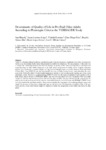| dc.contributor.author | Maseda, Ana | |
| dc.contributor.author | Lorenzo-López, Laura | |
| dc.contributor.author | Lorenzo, Trinidad | |
| dc.contributor.author | Diego-Díez, Clara | |
| dc.contributor.author | Alonso-Búa, Begoña | |
| dc.contributor.author | López-López, Rocío | |
| dc.contributor.author | Millán-Calenti, José Carlos | |
| dc.date.accessioned | 2018-03-14T09:43:04Z | |
| dc.date.available | 2018-03-14T09:43:04Z | |
| dc.date.issued | 2017-02-04 | |
| dc.identifier.citation | Maseda, A., Lorenzo-López, L., Lorenzo, T. et al. Determinants of quality of life in pre-frail older adults according to phenotypic criteria: the VERISAUDE Study. Applied Research Quality Life 13, 119–136 (2018). https://doi.org/10.1007/s11482-017-9510-2 | es_ES |
| dc.identifier.issn | 1871-2584 | |
| dc.identifier.issn | 1871-2576 | |
| dc.identifier.uri | http://hdl.handle.net/2183/20308 | |
| dc.description.abstract | [Abstract] Frailty is a dynamic clinical syndrome considered as part of an age-associated continuum of severity, including pre-frailty as an intermediate frailty status with potential reversibility to robustness. The main purpose of this study was to analyse the relationship between the different domains of quality of life, functional dependence and depressive symptomatology in older adults diagnosed as pre-frail, before progression to frailty occurs. Logistic regression analyses were conducted to examine whether sex, age, level of education and scores in the Geriatric Depression Scale 15-item Short Form (GDS-SF) and the Instrumental Activities of Daily Living Lawton scale determine the worst score in the WHOQOL-BREF (World Health Organization Quality of Life) in older adults meeting one or two frailty phenotypic criteria. Depressive symptomatology (GDS-SF score) was the main determinant of poor quality of life in both groups, and in all areas of WHOQOL-BREF. Age was only associated with poor satisfaction with own health. Female sex and low educational level were linked to low physical QOL and poor self-rated health, respectively, but only in older adults meeting one frailty criterion. Association between functional status and WHOQOL-BREF scores was only found in the univariate analysis. These results underline the importance of identifying multiple aspects, but mainly the presence of depressive symptomatology, as risk factors for all dimensions of quality of life in the pre-frailty process, where interventions might be targeted to reduce the progression of pre-frailty and frailty in older adults. | es_ES |
| dc.description.sponsorship | Xunta de Galicia; EM 2012/100 | es_ES |
| dc.description.sponsorship | Xunta de Galicia; IN607C, 2016/08 | es_ES |
| dc.language.iso | eng | es_ES |
| dc.publisher | Springer para The International Society for Quality-of-Life Studies (ISQOLS) | es_ES |
| dc.relation.uri | http://dx.doi.org/10.1007/s11482-017-9510-2 | es_ES |
| dc.rights | The final publication is avaliable at Springer Link | es_ES |
| dc.subject | Depressive symptomatology | es_ES |
| dc.subject | Frailty | es_ES |
| dc.subject | Functional status | es_ES |
| dc.subject | Older adults | es_ES |
| dc.subject | Quality of life | es_ES |
| dc.title | Determinants of quality of life in pre-frail older adults according to phenotypic criteria: the VERISAUDE Study | es_ES |
| dc.type | info:eu-repo/semantics/article | es_ES |
| dc.rights.access | info:eu-repo/semantics/openAccess | es_ES |
| UDC.journalTitle | Applied Research in Quality of Life | es_ES |
| UDC.volume | 13 | es_ES |
| UDC.issue | 1 | es_ES |
| UDC.startPage | 119 | es_ES |
| UDC.endPage | 136 | es_ES |






